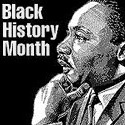
February is African American History Month! ![]()

![]()
 African American art
African American art
By Richard J. Powell
Arts and Crafts during the Colonial, Federalist, and Antebellum Years
During America’s infancy (in the period between the 1600s and the early 1800s), what one could describe as African American art indeed embraced a range of forms and definitions. A small drum, several wrought-iron figures, dozens of ceramic face vessels, and a few examples of domestic architecture found among enslaved black communities in the southern United States have been singled out for their similarities with comparable crafts, functional objects, and structures in West and Central Africa. In contrast, black artisans like the New England-based engraver Scipio Moorhead and the Baltimore portrait painter Joshua Johnson created art that, despite occasional portrayals of black subjects, was conceived in a thoroughly western European fashion. Other workshop- or academically-trained African American artists prior to the American Civil War (1861-1865) -- New Yorkers Patrick Reason and William Simpson, Philadelphian Robert Douglass, and the New Orleans- and Paris-based brothers Daniel and Eugene Warburg -- also created works of art that were indistinguishable from those of white printmakers, painters, and sculptors.
Examples:

African American, Virginia, Wood Drum, late 17th or early 18th century, wood, height 18 inches, British Museum, described as produced by a slave in John M . Vlach, The Afro-American Tradition in Decorative Arts (Cleveland Museum of Art, 1978); this photo is fig. 5, p. 20.

Joshua Johnson (American, c.1763-1824), Edward and Sarah Rutter, c. 1805, oil on canvas, 36 x 32 inches (91.4 x 81.3 cm), Metropolitan Museum of Art, NY.

Joshua Johnson, The Westwood Children, c. 1807, oil on canvas, National Gallery of Art, Washington D.C.

Joshua Johnson, Mrs. McCurdy and Her Daughters, Mary Jane and Letitia, after 1806, oil on canvas, 44 x 38-3/4 inches (111.76 x 98.43 cm), Corcoran Gallery, Washington, DC.

African American, Slave Pottery Jug, glazed ceramic in the form of a head, American Museum in Britain, Bath, whose curator says, "Slave pottery was known as Colono Ware. . . . It is possible that the face on this bottle represents Abraham Lincoln. Such jugs may have been made by slaves to protect the souls of the dead. They would have left them in graveyards." See death.
This is part 2 of ArtPage on African American art
_____
The author of this article, Richard J. Powell PhD, is a professor of art and art history at Duke University who specializes in American, African American and African art. His books include Homecoming: The Art and Life of William H. Johnson (1991), Rhapsodies in Black: Art of the Harlem Renaissance (1997), and Black Art: A Cultural History (2002).
Copyright © 2005 Oxford University Press. All rights reserved. Excerpted from Africana: The Encyclopedia of the African and African American Experience, second edition. Edited by Henry Louis Gates Jr. and Kwame Anthony Appiah. Thanks to Yolanda Carden for permission to post this excerpt in ArtPage.
Oxford University Press; April 2005; 5 Volumes; 4,500 pp.; 0-19-517055-5; Special introductory price until April 30th, 2005 of US $425.00. After April 30th, 2005, the price will be US $500.00. Please visit the Oxford University Press for ordering information.
Ninety years after W.E.B. Du Bois first articulated the need for “the equivalent of a black Encyclopedia Britannica,” Kwame Anthony Appiah and Henry Louis Gates Jr., realized his vision by publishing Africana: The Encyclopedia of the African and African American Experience in 1999. This new multi-volume edition of the original work expands on the foundation provided by Africana. More than 4,000 articles cover prominent individuals, events, trends, places, political movements, art forms, business and trade, religion, ethnic groups, organizations and countries on both sides of the Atlantic.
Kwame Anthony Appiah is the Lawrence S. Rockefeller Professor of Philosophy and the University Center for Human Values at Princeton University.
Also see multiculturalism, xenophilia, and xenophobia.
https://inform.quest/_art
Copyright © 1996-![]()